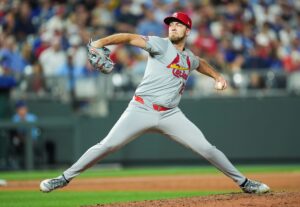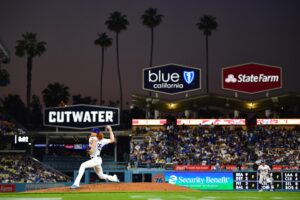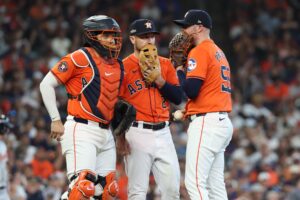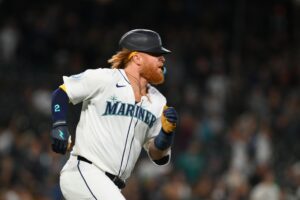With the 2017 regular season winding down, Major League Baseball’s end-of-season award hopefuls have just under a week remaining to cap off their individual campaigns and present their final case to the Baseball Writers Association of America (BBWAA). Of MLB’s major accolades, the most prominent are the two MVP awards, recognizing the Most Valuable Player in each league. After coming close on numerous occasions, 2017 is finally the year for Arizona Diamondbacks first baseman Paul Goldschmidt to take home the NL MVP crown.
Paul Goldschmidt is the 2017 NL MVP
Sizing up the Competition
Before analyzing Goldschmidt’s case, we first must examine the competition he is up against. The most common names in the MVP conversation in the National League are Miami Marlins slugger Giancarlo Stanton, Washington Nationals superstar Bryce Harper, and Colorado Rockies two-way force Nolan Arenado, all of whom offer Goldschmidt a run for his money.
The biggest threat to Goldschmidt of the three is probably Stanton, whose spectacular display of power particularly after the All-Star break has dominated the media landscape. For obvious reasons, people tend to gravitate towards the home run tally – which currently stands at 57 and counting entering play Monday – but dingers aren’t the whole story. While Stanton has a decided edge in round trippers and also boasts six more RBI, the batting average is significantly lower and the strikeout numbers are higher compared to Goldschmidt.
Moreover, Stanton faces the same critical disadvantage in the race that Goldschmidt did multiple times in seasons past: the Marlins aren’t good enough. In fact, Miami’s 73-82 record (.471 win percentage) is worse than Arizona’s record in 2013 (81-81) and 2015 (79-83) when Goldschmidt finished second in MVP voting. Given the precedent the BBWAA has set by leaning towards players on playoff teams, Stanton’s Marlins aren’t in the position where he meets that requirement. Stanton is a world class talent who brings a truly unique skillset to the ballpark each and every day, but he isn’t the National League’s Most Valuable Player in 2017.
Next, we have the curious case of Harper. The Nationals (94-61) have a better record than the D-backs (90-66), Harper has a better batting average by more than 20 points, and his counting stats measured as an average if stretched out to 150 games also give Harper a slight edge. But Harper’s case is clouded over by the knee injury suffered back in mid August, from which he still hasn’t returned. Also complicating matters is the stacked Nationals batting order with Ryan Zimmerman (slashing .302/.357/.563 to go along with 34 HR & 103 RBI) and Anthony Rendon (who quietly leads the NL in WAR at 6.7) both enjoying career best seasons statistically, while Daniel Murphy is coming off of a 2016 campaign where he was the NL batting title runner-up. Plus, we haven’t even mentioned NL Cy Young favorite Max Scherzer and Stephen Strasburg forming a dominant one-two punch in the starting rotation.
When it comes to who is most valuable, the Nationals clearly have the firepower to get by without Harper. That is backed up by the Nats’ 26-16 record (.619 win percentage) since Harper sustained his injury on August 12, compared to their 69-45 record (.605 win percentage) this season before the injury. Getting hurt was an unfortunate break for Harper, but the reality is that his extended absence has been a damaging blow to his MVP chances.
Arenado, meanwhile, puts forth an intriguing argument given his frequent head-to-head meetings with Goldschmidt’s Diamondbacks in the NL West. Hampering Arenado’s case somewhat is the excellent year teammate Charlie Blackmon has had at the plate, but Arenado has two major factors going in his favor: better counting stats and Gold Glove caliber defense.
Compared to Goldschmidt at first base, as well as Stanton and Harper in right field, Arenado makes far more of an impact at the hot corner as arguably the best defensive third basemen in the game. Add that label to his 34 homers, 84 extra base hits, and Major League-leading 126 RBI and you get a very compelling case for the NL’s Most Valuable Player.
Then again, the baseball world is well aware of the Coors Field effect, which goes a long way to inflating offensive numbers. Plus, the Rockies are worse than the D-backs, and will be heading out on the road to Phoenix for the NL Wild Card game at Chase Field in just over a week’s time, assuming Colorado can fend off the Milwaukee Brewers and St. Louis Cardinals in the final week of the season for the final NL postseason berth.
Another factor to take into consideration is the personalities of these players, fueled by the markets they play in. If it were a popularity contest, Goldschmidt wouldn’t stand a chance. That’s because unlike Harper and Stanton, he doesn’t engage in hot takes on ‘making baseball fun again’ or the legitimacy of the home run record held by Barry Bonds. Goldschmidt simply isn’t interested in attracting headlines, in large part due to his down-to-earth personality. But even if he was, the fact that he plays in a relatively small and isolated market in the western United States where home games begin when most people in the eastern time zone are heading to bed further depletes his already limited media exposure.
Of the lot, Goldschmidt is by far the quietest and most boring. There are no exorbitant bat flips here, nor are there 120-plus mile per hour exit velocities, and he also doesn’t reap the rewards of playing at Coors Field 81 times a year. There is, however, immaculate consistency and across the board productivity that – while not as newsworthy – is just as impressive.
Consistency at the Plate
Goldschmidt has been among the most consistently elite hitters in the game since 2012. But because the MVP is a season-long award, let’s take an expanded look at his 2017 sample size.
For starters, he is among the MLB’s best when it comes to the popular counting stats with a .306 average, 36 homers, and 120 RBI good for third in baseball. Goldschmidt also stacks up well in the secondary counting stats, ranking third in the NL in runs scored (115) and On Base Percentage (.412), fourth in walks (92), fifth in Slugging Percentage (.579) and OPS (.991), and eighth in stolen bases (18) despite not being known as a traditional speed threat.
Furthermore, advanced sabermetrics confirm Goldschmidt’s place among the league’s best at the dish. This season, Goldschmidt posted the third-highest hard contact rate in baseball (44.8%), coupled with the third lowest soft contact rate (10.8%). Despite trailing Stanton by 21 home runs, he has created just five fewer runs (127) than Stanton (132) according to Fangraphs’ Weighted Runs Created metric, and more than both Arenado (120) and Harper (99).
Clearly, Goldschmidt’s numbers purely from 2017 are good enough to give him the MVP on their own. But when you take into account the consistency of his production over the past several seasons, it becomes apparent that one of these years he deserves to be recognized.
Since 2012, Goldschmidt ranks first in the National League in RBI, second in OPS, third in home runs, and sixth in stolen bases. From a sabermetric standpoint, he is first in Win Probability Added, second in Weighted Runs Created, and fourth in Wins Above Replacement at 31.2 behind Joey Votto (36.2), Andrew McCutchen (36.2), and Buster Posey (31.3).
Anything jump out at you with respect to what those three names have in common? All of them have added an NL MVP to their trophy cases since 2010. It’s about time Goldschmidt finally received one to match.
Under-the-Radar Defense & Speed
One factor going against Goldschmidt is his position at first base, which doesn’t allow him to make significant contributions on the defensive side of the ball. Granted, neither Stanton nor Harper add a ton more defensively stuck out in right field, but Arenado certainly does as the recipient of the last four NL Gold Gloves at third base.
Although he may not have the opportunity to make highlight reel plays, Goldschmidt is still an elite defensive player at his position. This season, he led all MLB first basemen in Revised Zone Rating, a metric designed to measure both a fielder’s range and efficiency in converting balls hit into their zone into outs. This was in large part due to Goldschmidt also pacing his position with the most “balls out of zone plays made”, highlighting his elite range at first. As a result, Goldschmidt tied for the most Defensive Runs Saved among MLB first basemen with 10.
Furthermore, Goldschmidt also contributes much more than the traditional slugger on the base paths thanks to his deceptive speed and baseball IQ. Goldschmidt has stolen 18 bases thus far in 2017 and has just under a week remaining to try to swipe two more to record his third consecutive 20-20 season. Those 18 bags swiped also rank second in stolen bases by a first basemen after Wil Myers, and top 20 in the MLB overall.
Goldschmidt is average at best in terms of foot speed, but as R.J. Anderson outlined in a 2016 article for CBS Sports, his exceptional baseball instincts and feel for the game are what allow Goldschmidt to be so effective on the base paths.
Conclusion
The MVP award recognizes the best single-season performance in each league. Thus, BBWAA voters aren’t supposed to take anything else from other years into account, but in Goldschmidt’s case it’s hard not to.
To put it bluntly, Goldschmidt was the lone superstar on some pretty bad Diamondbacks teams from 2012-2016. Over that span, he finished second in NL MVP voting twice, was credited with two Silver Slugger and Gold Glove awards each, and has represented the NL as an All-Star five years running.
Now that Goldschmidt finally has some help, the one missing element of his MVP case is no longer missing. The D-backs are very good and Goldschmidt is their best player. It’s about time the BBWAA recognized him with the National League’s MVP award.






